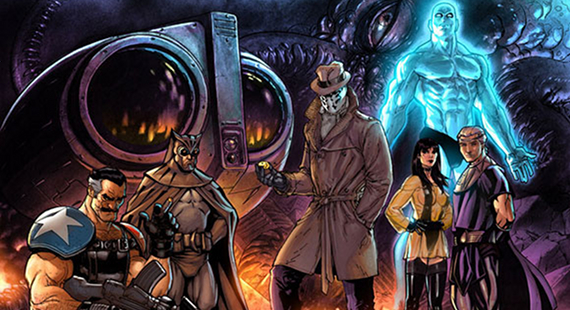It wasn’t long ago that DC Comics put out the announcement that they’d be creating a line of comics as preludes to Alan Moore’s graphic novel tour de force, Watchmen. Twenty-six years after its release to the comic-reading world, Watchmen still stands as one of the greatest examples of graphic form storytelling with its nuanced, complex tale of Cold War politics and personal responsibility.
Currently, the world of Watchmen is being revisited by some of the biggest names in the comic business. Creatives like Brian Azzarello, Len Wein, J. Michael Straczynski, and Darwyn Cooke (with nary an Alan Moore to be seen) are writing and drawing away on several mini-series comprising the Before Watchmen project.
When the Before Watchmen project was announced there was an immediate divide within the comic community. Many supported the calls to ignore a project that creator Alan Moore has gone on record as holding “in complete contempt.” Dave Gibbons, the original artist for Watchmen, did lend his support but not his involvement, and DC publisher Dan DiDio even admitted that opinions on the project in-house at DC were divided. Still, Before Watchmen went forward and launched to a myriad of variant covers and fanfare.
But the question remains: Should the project even have existed? And more importantly: Is it any good? With titles dedicated to Nite Owl, the Minutemen, Ozymandias, Silk Spectre, and The Comedian already released, let’s take a look mid-stream at the project so far and discuss the necessity of revisiting a comic book legend.
Spoilers ahead for Before Watchmen and Watchmen.
Before Watchmen: Minutemen (Darwyn Cooke)
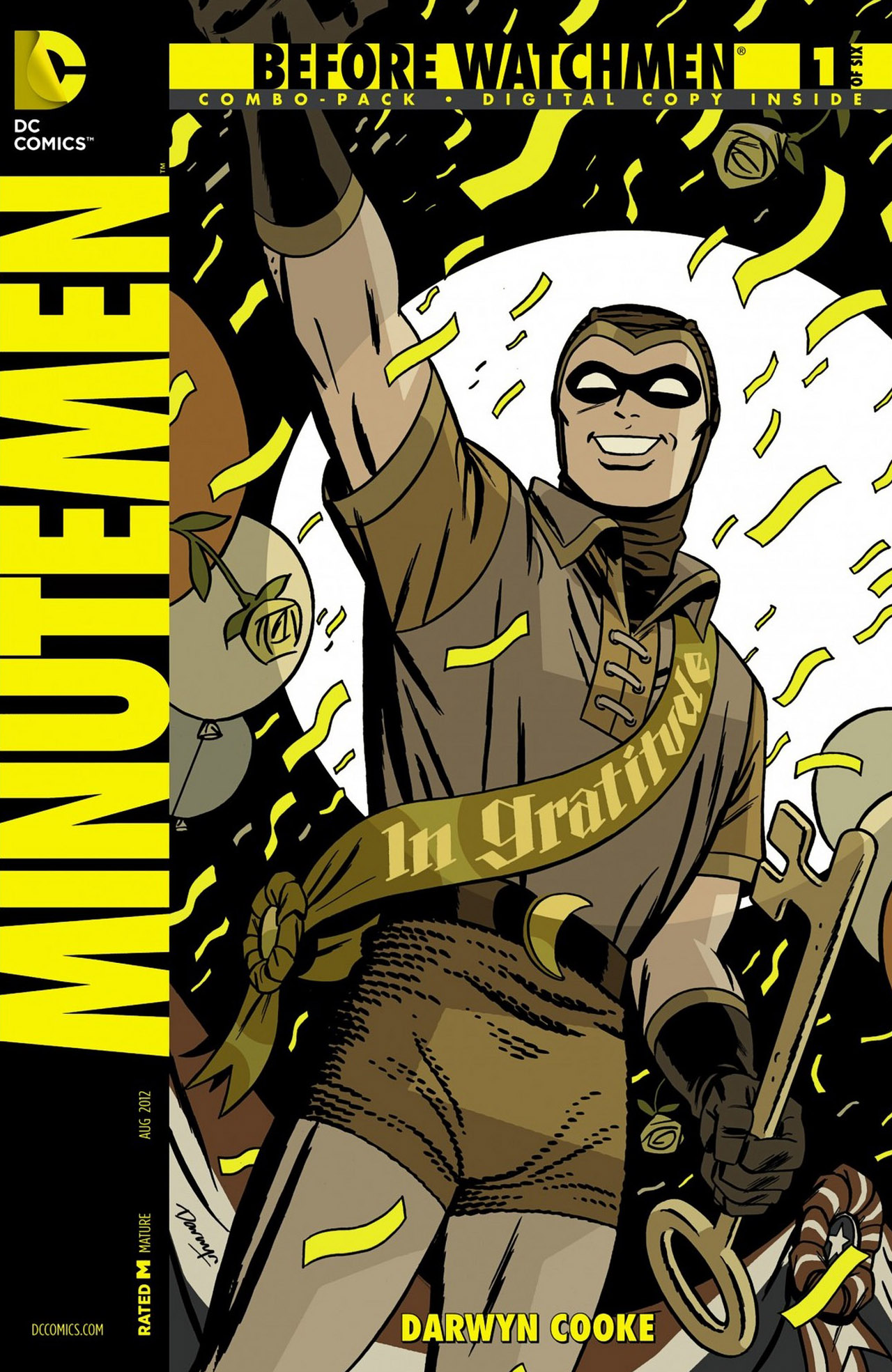 Of all the Before Watchmen offerings, this is the book with the most to offer Watchmen fans. Much of what we know about the Minutemen in Watchmen is told in flashback and is often couched in conflicting accounts and innuendo. Minutemen follows the original Nite Owl as he gives us a look into the evolution of the original team and the behind-the-scenes personal dynamics that were only hinted at in the original. There is an aura of sad heroism and fragile idealism that permeates the piece that makes it compelling, especially in the sections regarding the Silhouette and her war on crime. The comic also further illuminates the personal relationships between the characters that were only hinted at in the original Watchmen, including the relationships previously considered more hush-hush, like the somewhat twisted partnership between Hooded Justice and Captain Metropolis. Darwyn Cooke also has the pulse of the time period well-explored in the writing, balancing between Hollis Mason’s more white-knight idealism and the darker undertones of the Watchmen universe. Out of all of the books so far, I believe this one contains much of the spirit of the original material while still bringing something new to the table.
Of all the Before Watchmen offerings, this is the book with the most to offer Watchmen fans. Much of what we know about the Minutemen in Watchmen is told in flashback and is often couched in conflicting accounts and innuendo. Minutemen follows the original Nite Owl as he gives us a look into the evolution of the original team and the behind-the-scenes personal dynamics that were only hinted at in the original. There is an aura of sad heroism and fragile idealism that permeates the piece that makes it compelling, especially in the sections regarding the Silhouette and her war on crime. The comic also further illuminates the personal relationships between the characters that were only hinted at in the original Watchmen, including the relationships previously considered more hush-hush, like the somewhat twisted partnership between Hooded Justice and Captain Metropolis. Darwyn Cooke also has the pulse of the time period well-explored in the writing, balancing between Hollis Mason’s more white-knight idealism and the darker undertones of the Watchmen universe. Out of all of the books so far, I believe this one contains much of the spirit of the original material while still bringing something new to the table.
Before Watchmen: Silk Spectre (Darwyn Cooke)
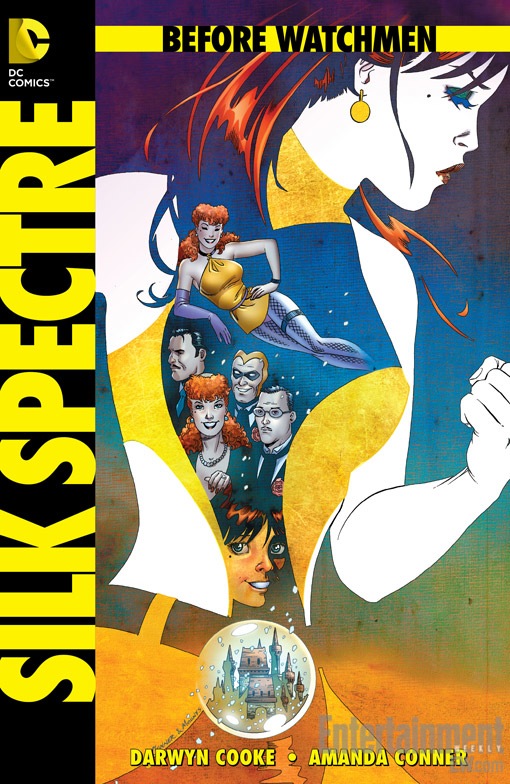 Another offering from Darwyn Cooke is the story of Silk Spectre II aka Laurie Jupiter, with art provided by Amanda Conner. In this series, Cooke strives to develop Laurie out of the perception of her as a sex object and token love interest with a coming of age story set in the high hippy 70’s. With lovely art and a poignant undertone of teenage angst, the battle that Laurie undergoes to distance herself from her mother’s sexually charged public identity, and their complicated relationship, is the most compelling part of this origin tale. Quite a bit of the female dynamic in the original Watchmen came down to Laurie embracing her heritage with her mother, and this prequel gives us a chance to see how the tension with Sally Jupiter shaped Laurie’s identity.
Another offering from Darwyn Cooke is the story of Silk Spectre II aka Laurie Jupiter, with art provided by Amanda Conner. In this series, Cooke strives to develop Laurie out of the perception of her as a sex object and token love interest with a coming of age story set in the high hippy 70’s. With lovely art and a poignant undertone of teenage angst, the battle that Laurie undergoes to distance herself from her mother’s sexually charged public identity, and their complicated relationship, is the most compelling part of this origin tale. Quite a bit of the female dynamic in the original Watchmen came down to Laurie embracing her heritage with her mother, and this prequel gives us a chance to see how the tension with Sally Jupiter shaped Laurie’s identity.
Still, what is offered doesn’t provide much to like for Laurie, so this story falls solidly in the “meh” category for me. Laurie’s story follows a pretty straight-forward teenage rebellion plot that feels contrived. This is a story we’ve seen a hundred times: Girl fights with mother, girl flees the nest with the first nice boy that comes along, girl gets in trouble in the big city. If getting in trouble means that she has to put on the costume and kick some butt, well, that feeds into the superhero story but it doesn’t give us anything surprising or powerful about Laurie herself, and that leaves the story sadly flat. Kudos, however, to Amanda Conner for capturing the spirit of flower power as it entered the 1970’s in her art. Although even that couldn’t save the blasé reaction I had to this comic.
Before Watchmen: The Comedian (Brian Azzarello)
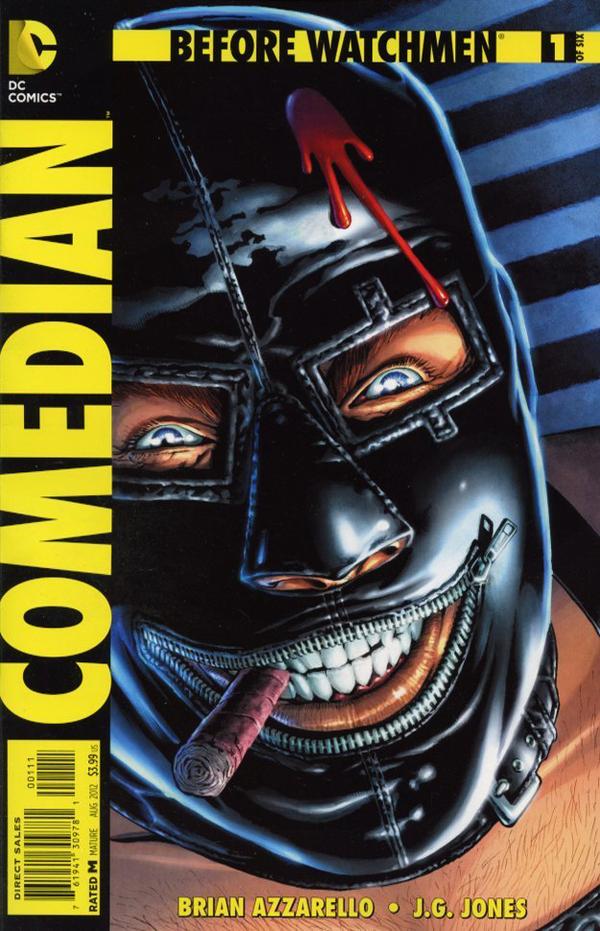 A blasé reaction however is a much better response to have than one of complete disbelief, which was my response to Brian Azzarello’s story about one of Watchmen‘s most complex characters, the Comedian. Azzarello’s retelling of Comedian’s time post-Minutemen has him acting as best buddy and personal super hero to JFK and Bobby Kennedy in the White House. They play ball together, laugh over women and ball games, all depicted in bright sun-shining glory in J. G. Jones’ beautiful art. Did I mention he has a flirty, serious conversation with Jackie O about the dangers of slutty Marilyn Monroe?
A blasé reaction however is a much better response to have than one of complete disbelief, which was my response to Brian Azzarello’s story about one of Watchmen‘s most complex characters, the Comedian. Azzarello’s retelling of Comedian’s time post-Minutemen has him acting as best buddy and personal super hero to JFK and Bobby Kennedy in the White House. They play ball together, laugh over women and ball games, all depicted in bright sun-shining glory in J. G. Jones’ beautiful art. Did I mention he has a flirty, serious conversation with Jackie O about the dangers of slutty Marilyn Monroe?
The concept of the Comedian palling around with JFK struck such a negative chord with me that I had to stop reading to consider why this would be the rewrite they gave for the Comedian. This is a character shown to be brutal and complex, an anti-establishment man working with ironic discontent within the system. Yet, Azzarello seems bent on trying to score emotional by giving him a relationship with a beloved president who was killed. Here, the story seems to say, here is the reason the Comedian turned out the way he did, here is something he did care about, just like everyone in that generation. If this was meant to humanize the Comedian or explain more about his personality later on in his life, it comes across as wholly off-tone and bizarre. Whatever humanizing or explanation needed for the Comedian was done in the original work, and this attempt to recontextualize the Comedian just comes off as a cheap ploy by using the assassination of an American president as emotional fodder.
Before Watchmen: Ozymandias (Len Wein)
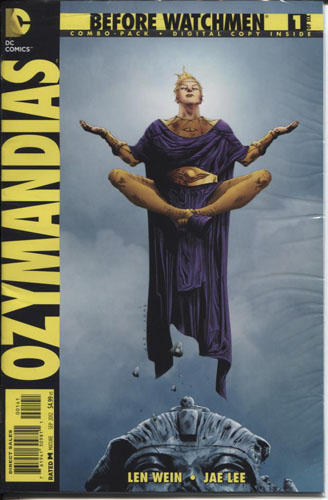 Another weak offering in this line-up has been the first issue of the Ozymandias storyline. Ozymandias works as a character in Watchmen because we know very little about him. He is an aloof super-genius who genetically engineers everything from his weapons of mass destruction to his pets and slaughters indiscriminately to save the world with his mega-schemes. The problem with telling us more about the backstory of little Adrian growing up is that his story is so boring. He was brilliant from birth, exceptional in school, snooty from the time he was able to narrate at us, and so detached and aloof in all his relationships that connecting to the character is almost impossible. I’d be more inclined to follow a story about Bubastis and find the ability to empathize with the giant cat than to connect to the arched, lofty attitude of Ozymandias. Also the explanation for his becoming a costumed hero is so badly strung together as to be laughable.
Another weak offering in this line-up has been the first issue of the Ozymandias storyline. Ozymandias works as a character in Watchmen because we know very little about him. He is an aloof super-genius who genetically engineers everything from his weapons of mass destruction to his pets and slaughters indiscriminately to save the world with his mega-schemes. The problem with telling us more about the backstory of little Adrian growing up is that his story is so boring. He was brilliant from birth, exceptional in school, snooty from the time he was able to narrate at us, and so detached and aloof in all his relationships that connecting to the character is almost impossible. I’d be more inclined to follow a story about Bubastis and find the ability to empathize with the giant cat than to connect to the arched, lofty attitude of Ozymandias. Also the explanation for his becoming a costumed hero is so badly strung together as to be laughable.
His girlfriend, whom we barely get to know in the story, is so stung by Adrian’s disconnected inattention to her that she goes out and overdoses on drugs. In a fit of rage, Ozymandias picks up little pieces of his collection of impossibly well-placed artifacts (plus a Halloween costume he just has lying around) to become a costumed “hero.” For all his beautiful language, Len Wein has no traction on a likable character in Adrian. The only thing to purchase this comic for is the art, as Jae Lee is delivers stunning (as usual) portrayals of the worldwide traveling that proto-Ozymandias undertakes. If only the book could live up to Jae Lee’s work, we’d have something interesting to read.
Before Watchmen: Nite Owl (J. Michael Straczynski)
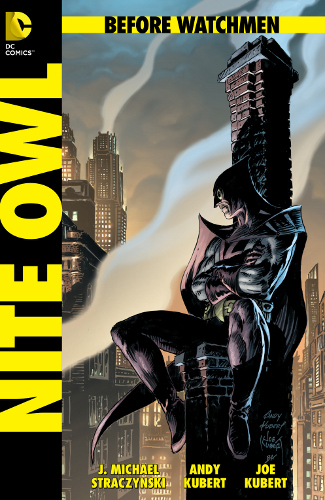 Coming full circle, we have a great example of what I’d call an unnecessary but surprisingly brilliant piece of writing in Nite Owl. Penned by J. Michael Straczynski with art by Andy and Joe Kubert, the Nite Owl story is exactly the kind of origin you want to read. It packs emotional complexity and depth into a character that was ripe for exploration, and brings up the little nuances of relationships previously explored in Watchmen in new ways. Straczynski’s exploration of Daniel Drieberg’s quest to become the Nite Owl’s protege is a fresh contribution to the Watchmen world and provides a quirky view into the relationship between Drieberg and Hollis Mason.
Coming full circle, we have a great example of what I’d call an unnecessary but surprisingly brilliant piece of writing in Nite Owl. Penned by J. Michael Straczynski with art by Andy and Joe Kubert, the Nite Owl story is exactly the kind of origin you want to read. It packs emotional complexity and depth into a character that was ripe for exploration, and brings up the little nuances of relationships previously explored in Watchmen in new ways. Straczynski’s exploration of Daniel Drieberg’s quest to become the Nite Owl’s protege is a fresh contribution to the Watchmen world and provides a quirky view into the relationship between Drieberg and Hollis Mason.
The story also explores Drieberg as a brilliant young man with a dark past, whose idealism carries him through the tumultuous times between the “glory days” of the original Minutemen into the later Cold War era of costumed “heroes.” A special nod should go to the introduction of the partnership (should we call it friendship?) of Drieberg and Rorschach. Their first meeting, including the dialogue between Rorschach and Silk Spectre II, is priceless. This comic stands as a solid contribution to the Watchmen mythos just by the sheer amount of interesting new material created between the cracks of a story we already know, which was supposedly the purpose of Before Watchmen all along. Straczynski presents that material without violating the spirit of the old characters and that makes the Nite Owl comic worth looking at.
With the Doctor Manhattan and Rorschach comics forthcoming and the completion of the above storylines coming in the next few weeks, there’s still room for growth in the Before Watchman series. Still, the comics as they are now don’t address why this was even necessary. A canny consumer might consider this is an attempt to capitalize on the Watchmen name in an attempt to generate sales. And if we were going to analyze these comics through a marketing lens, then maybe that is the motivation for this project.
Still, in an era where the issue of creative control for writers, especially in the comic industry, has been such a hot-button topic, I wonder why DC is retreading old ground rather than finding the next generation of Alan Moores to nurture and support. There might be some interesting creations within the Before Watchmen series, but the project itself feels forced and contentious, a rigid framework in which comic book giants are forced to play within someone else’s sandbox, their brilliant capabilities constrained.
But more than anything else, I come back to Alan Moore, who brought this entire world into being with Dave Gibbons, and wonder why I should get behind an add-on series when the original creators aren’t there to foster the vision into being. Whether DC likes it or not, the original book is identified as Alan Moore’s Watchmen and putting these iconic characters into the hands of others feels hollow in the face of it’s epic predecessor. At best, Before Watchmen offers little grains of well-written character insight where none seemed necessary. At worst, it reads like badly thought out fanfiction, and I expected just a little bit more from such a major project.
Shoshana Kessock is a comics fan, photographer, game developer, LARPer and all around geek girl. She’s the creator of Phoenix Outlaw Productions and ReImaginedReality.com.










